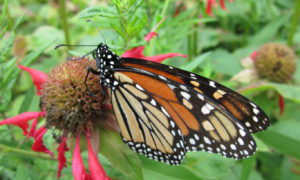Bee Lines: Pollinator friendly landscapes
by Sam Hall –

At this time of year I am getting my gardens ready for the winter and spring. I’m hoping you will give some thought to making your spring lawn and garden pollinator friendly. As a society we seem to have developed a culture that favors weedless lawns that look like miniature golf courses. If you are one of those that adheres to that idea, read no further.
I’m at an age that I seldom get really angry at anything especially something I see on TV but I did a while back. You may remember a TV ad showing a man dressed somewhat like a cowboy but instead of a gun he carried a sprayer connected to a can of Roundup with music in the background which I believe was the theme from the TV show Rawhide. He was in his driveway and through a small crack in the pavement a beautiful dandelion had dared to not only grow but bloom. It was delightful to see. Then the dressed up cowboy demonstrated that Roundup could not only kill the blossom and stem but the root of the plant as well.
A few years ago a beekeeper friend put thirteen colonies of honey bees down along County Road 32 and lost them all after the County sprayed the roadside with Roundup. Now you are probably aware that it is alleged that Roundup may cause certain types of cancer. Perhaps the honeybees were unwittingly, the canary in the mine. It seems to be that when a fungicide will kill living plants it is not particularly good for humans. I remember DDT and Parathion when they first came onto the market being hailed as manna from heaven, now they are banned in most countries not for their effect on plants but you and I.
Why not plant our lawns to American wild flowers? I am slowly converting my front yard to wild flowers. One of the side benefits is you don’t have to mow your lawn. In fact since they are self seeding there is almost no care at all. I have only a small strip that I did this year and hope to double it this coming year. Lowe’s carries an American wild flower seed mixture as does many other stores. I will give you some advice that I did not have. To plant wild flowers you simply scatter the seeds on the ground. When you scatter the seeds cover them with a moist burlap or other fabric for a few days. I did not and my first seeding went to the birds. I did not begrudge them their free meal but it was not my intention. After the first year the seeds drop onto the ground for the following years blossoms. The birds are not as interested in the seeds as they have to go amongst the standing plants to get at the seeds exposing them to predators such as the neighborhood cat.
This has been a different type of year in beekeeping. More rain than we’ve seen in most recent years and a longer and hotter than normal Indian summer. The Golden Rod nectar flow was extremely strong followed by a wild Aster flow which is still going on. Usually my wild Aster’s are two to three feet tall. This year I had some reach nearly six feet. I am still extracting honey whereas I’m usually done by the middle of September. It is too early to tell what effect this prolonged summer will have on the bees, if any.
Yesterday on my walk I saw a “Darning Needle”. I don’t know what the scientific name is. It was hovering by a few dead shafts of timothy. It’s wings were like a humming birds going so fast that you could not see them. It appeared that this small twig like creature could stand almost still in the air. I watched it for several seconds then I took a video of it which I would share with anyone interested.
When I am outdoors or in the woods I try to be aware of everything around me which of course is impossible. Even if you cannot go to the woods you can always go to a park and look at nature and possibly realize that you are part of it too.
Sam Hall is a western NY beekeeper who first worked bees as a child growing up on a ‘dirt farm’ in Allegany County, NY. He has kept bees for most of his adult life and believes that his mistakes ‘far outnumber his successes.’